
The Elateroidea are a large superfamily of beetles. It contains the familiar click beetles, fireflies, and soldier beetles and their relatives. It consists of about 25,000 species.
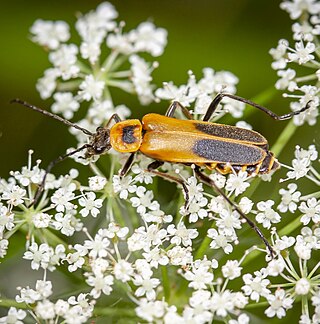
The goldenrod soldier beetle or Pennsylvania leatherwing is a species of soldier beetle (Cantharidae).

Chauliognathus is a genus of soldier beetles in the family Cantharidae. Adults have almost rectangular bodies. Some are red and black, similar to the military uniforms that were common before the usage of camouflage, hence the name of soldier beetles. Others are orange and black. The elytra or first pair of wings are softer than the elytra of most beetles, that is why their other common name is leatherwings. The adults are frequently found on flowers, such as sunflowers, goldenrod, coneflowers, where they mate and feed on pollen and nectar. The larvae are more common in the ground or among debris, where they feed on eggs or larvae of other insects. The adults are most frequently found in summer and early fall. They are native to America and Australia.

Chauliognathus lugubris, the plague soldier beetle, green soldier beetle or banana bug, is a species of soldier beetle (Cantharidae) native to Australia. It has a flattened body to 15 millimetres (0.59 in) long with a prominent yellow-orange stripe behind the black prothorax. The abdomen is yellow-orange but is mostly obscured by the metallic olive green elytra.
Eryniopsis lampyridarum is an entomopathogenic fungus and its host is the soldier beetle, either Chauliognathus marginatus or Chauliognathus pensylvanicus.Eryniopsis lampyridarum is mind controlling for the soldier beetle and can manipulate the beetle into doing things that it wouldn't normally do. Once the fungus has established itself inside the beetle, it sends the infected beetle on a mission to find a specific daisy flower Asteraceae. The soldier beetle will clamp its mouthpiece onto the flower as tight as it can, while it awaits its death. The parasitic fungus forces the dead beetle to then spread its wings wide in a dramatic pose; this makes the beetle look bigger as if it is seeking out a mate. The fungus makes sure the dying beetle will attract more beetles so it can spread its spores. The fungus makes sure the beetle spreads its wings only at daybreak. It is also strange that the beetle will be dead for hours and then suddenly it will spread its wings at daylight, just in time to attract potential mates to its dead body. This is because the fungus is in control of the beetle's body functions. Then, when an uninfected beetle comes along to socialize with the dead beetle, the fungus' spores spread to the new beetle.

Chauliognathinae is a subfamily of soldier beetles in the family Cantharidae. There are at least 4 genera and at least 20 described species in Chauliognathinae.
Chauliognathus fasciatus is a species of soldier beetle in the family Cantharidae. It is found in North America.

Chauliognathus scutellaris, the Texas soldier beetle, is a species of soldier beetle in the family Cantharidae. It is found in Central America and North America.
Acritus discus is a species of clown beetle in the family Histeridae. It is found in North America.
Chauliognathus lecontei is a species of soldier beetle in the family Cantharidae. It is found in North America.
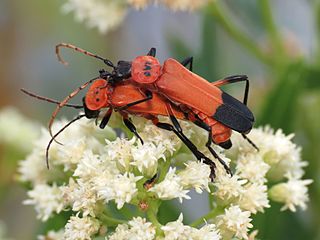
Chauliognathus profundus is a species of soldier beetle in the family Cantharidae. It is found in Central America and North America.
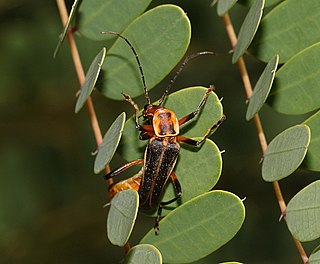
Chauliognathus obscurus is a species of soldier beetle in the family Cantharidae. It is found in North America.

Chauliognathus misellus is a species of soldier beetle in the family Cantharidae. It is found in North America.

Chauliognathus marginatus, known generally as the margined leatherwing or margined soldier beetle, is a species of soldier beetle in the family Cantharidae. It is found in Central America and North America. It is most commonly found on white flowers in spring and early summer.
Chauliognathus limbicollis is a species of soldier beetle in the family Cantharidae. It is found in North America.

Chauliognathus deceptus is a species of soldier beetle in the family Cantharidae. It is found in North America.

Chauliognathus basalis, the Colorado soldier beetle, is a species of soldier beetle in the family Cantharidae. It is found in North America.
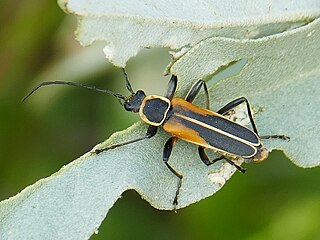
Chauliognathus opacus is a species of soldier beetle in the family Cantharidae. It is found in North America.
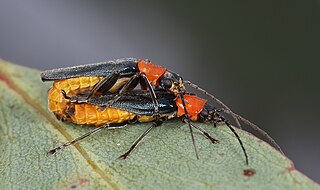
Chauliognathus tricolor, the Tricolor soldier beetle, is a species of soldier beetle in the family Cantharidae. It has a flattened body between 6 and 16 millimeters long with a prominent red-orange stripe behind the black prothorax. The abdomen is yellow-orange but is mostly obscured by the metallic olive green elytra.
Eryniopsis is a genus of fungi within the family of Entomophthoraceae and order Entomophthorales of the Zygomycota. This has been supported by molecular phylogenetic analysis.












